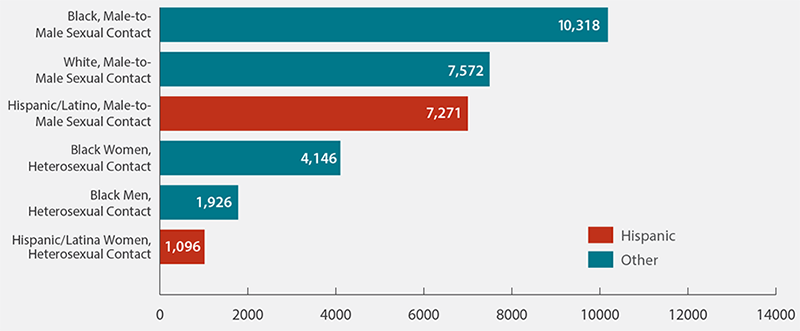HIV Among Hispanics/Latinos
Fast Facts
- Hispanics/Latinos are disproportionately affected by HIV.a
- About 7 in 10 new HIV diagnoses among Hispanics/Latinos occur in gay and bisexual men.b
- About half of Hispanics/Latinos living with HIV have achieved viral suppression.

HIV continues to be a serious threat to the health of the Hispanic/Latino community. In 2015, Hispanics/Latinos accounted for about one quarter of all new diagnoses of HIV in the United States, despite representing about 18% of the total US population.
The Numbers
New HIV Infections
From 2010 to 2014, estimated annual HIV infections increased 14% (from 6,400 to 7,300) among Hispanic/Latino gay, bisexual, and other men who have sex with men.c
HIV and AIDS Diagnosesc
- In 2015, Hispanics/Latinos accounted for 24% (9,798) of the 40,040 new diagnoses of HIV infection in the United States and 6 dependent areas.d Of those, 87% (8,563) were in men, and 12% (1,223) were in women.
- Gay and bisexual men accounted for 85% (7,271) of the HIV diagnoses among Hispanic/Latino men in 2015.
- Among Hispanic women/Latinas, 90% (1,096) of the diagnosed HIV infections were attributed to heterosexual contact.e
- From 2010 to 2014, HIV diagnoses increased 2% among all Hispanics/Latinos, but trends varied among subgroups.
- Diagnoses among Hispanic women/Latinas declined steadily (16%).
- Diagnoses among all Hispanic/Latino gay and bisexual men increased (13%).
- Diagnoses among young Hispanic/Latino gay and bisexual men (aged 13 to 24) increased 16%, a slower increase than in previous years.
HIV Diagnoses in the United States and 6 Dependent Areas for the Most-Affected Subpopulations, 2015

Source: CDC. Diagnoses of HIV infection in the United States and dependent areas, 2015. HIV Surveillance Report 2016;27.
Living With HIV and Deaths
- At the end of 2014, an estimated 235,600 Hispanics/Latinos were living with HIV in the United States. Of these, an estimated 17% were living with undiagnosed HIV.
- Among all Hispanics/Latinos living with HIV in 2014, 83% had received a diagnosis, 58% received HIV medical care in 2014, 48% were retained in HIV care, and 48% had a suppressed viral load.f
- In 2014, 916 deaths among Hispanics/Latinos were attributed directly to HIV.
Prevention Challenges
Why are Hispanics/Latinos at higher risk?
In all communities, lack of awareness of HIV status contributes to HIV transmission. People who do not know they have HIV cannot take advantage of HIV care and treatment and may unknowingly pass HIV to others. A number of challenges contribute to the higher rates of HIV infection among Hispanics/Latinos:
- More Hispanics/Latinos are living with HIV than some other races/ethnicities.
- Hispanics/Latinos have higher rates of some STDs than some other races/ethnicities. Having another STD can increase a person’s chance of getting or transmitting HIV.
- Though not unique to Hispanics/Latinos, stigma, fear, discrimination, and homophobia impact Hispanic/Latino lives. These issues may put many Hispanics/Latinos at higher risk for HIV infection.
- Poverty, migration patterns, lower educational level, and language barriers may make it harder for Hispanics/Latinos to get HIV testing and care.
- Undocumented Hispanics/Latinos may be less likely to use HIV prevention services, get an HIV test, or get treatment if HIV-positive because of concerns about being arrested and deported.
What CDC Is Doing
CDC and its partners are pursuing a high-impact prevention approach to advance national HIV prevention goals and maximize the effectiveness of current HIV prevention methods. Activities include
- Support and technical assistance to health departments and community-based organizations (CBOs) to deliver effective prevention interventions for Hispanics/Latinos:
- Starting in 2012, CDC has awarded at least $330 million each year under the current funding opportunity for health departments to direct resources to the populations and geographic areas of greatest need and prioritize the HIV prevention strategies that will have the greatest impact.
- In 2017, CDC awarded nearly $11 million per year for 5 years to 30 CBOs to provide HIV testing to young gay and bisexual men of color and transgender youth of color, with the goals of identifying undiagnosed HIV infections and linking those who have HIV to care and prevention services.
- The Act Against AIDS initiative, which raises awareness about HIV through multiple campaigns and partnerships such as
- Let’s Stop HIV Together (Detengamos Juntos el VIH), which raises awareness about HIV and its impact on the lives of all Americans.
- Doing It (Lo Estoy Haciendo / La Prueba del VIH), which motivates individuals to get tested for HIV and know their status.
- Start Talking. Stop HIV. (Inicia la conversación. Detén el VIH.), which encourages open discussion about a range of HIV prevention strategies and related sexual health issues between sex partners.
- Partnering and Communicating Together (PACT), a 5-year partnership with organizations such as the National Hispanic Medical Association to raise awareness about testing, prevention, and retention in care among populations disproportionately affected by HIV, including Hispanics/Latinos.
a Hispanics/Latinos can be of any race.
b The term male-to-male sexual contact is used in CDC surveillance systems. It indicates a behavior that transmits HIV infection, not how individuals self-identify in terms of their sexuality. This fact sheet uses the term gay and bisexual men.
c Estimated annual HIV infections are the estimated number of new infections (HIV incidence) that occurred in a particular year, regardless of when those infections were diagnosed. HIV and AIDS diagnoses indicate when a person is diagnosed with HIV or AIDS, not when the person was infected.
d Dependent areas: American Samoa, Guam, the Northern Mariana Islands, Puerto Rico, the Republic of Palau, and the US Virgin Islands.
e Heterosexual contact with a person known to have, or be at high risk for, HIV infection.
f People are considered retained in care if they get two viral load or CD4 tests at least 3 months apart in a year. (CD4 cells are the cells in the body’s immune system that are destroyed by HIV.) Viral suppression is based on the most recent viral load test.
Additional Resources
Bibliography
- Diagnoses of HIV infection in the United States and dependent areas, 2015. HIV Surveillance Report 2016;27.
- US Census Bureau. State and County QuickFacts. Accessed July 2017.
- Diagnoses and prevalence of HIV infection among Hispanics/Latinos—United States, 2008-2013. MMWR 2015;64(39):1097-103.
- Monitoring selected national HIV prevention and care objectives by using HIV surveillance data: United States and 6 dependent areas—2015. HIV Surveillance Supplemental Report 2017;22(2).
- National Vital Statistics Report: Death Leading Causes for 2014. Accessed July 2017.
- Reisen CA, Zea MC, Bianchi FT, Poppen PJ, Shedlin MG, Penha MM. Latino gay and bisexual men’s relationships with non-gay-identified men who have sex with men. J Homosex 2010;57(8):1004-21. Accessed July 2017
- Sexually Transmitted Disease Surveillance 2014. November 2014. Accessed July 2017.
- Albarracin J, Plambeck CR. Demographic factors and sexist beliefs as predictors of condom use among Latinos in the USA. AIDS Care 2010;22(8):1021-8. Accessed July 2017.
- Shedlin MG, Decena CU, Oliver-Velez D. Initial acculturation and HIV risk among new Hispanic immigrants. J Natl Med Assoc 2005;97(7 Suppl):32S-37S. Accessed July 2017.
- Duran D, Usman HR, Beltrami J, Alvarez ME, Valleroy L, Lyles CM. HIV counseling and testing among Hispanics at CDC-funded sites in the United States, 2007. Am J Public Health 2010;100(Suppl 1):S152-8. Accessed July 2017.
- del Rio C. Latinos and HIV care in the southeastern United States: new challenges complicating longstanding problems. Clin Infect Dis 2011;53(5):488-9. Accessed July 2017.
- Page last reviewed: September 26, 2017
- Page last updated: September 26, 2017
- Content source: Division of HIV/AIDS Prevention, National Center for HIV/AIDS, Viral Hepatitis, STD, and TB Prevention, Centers for Disease Control and Prevention


 ShareCompartir
ShareCompartir